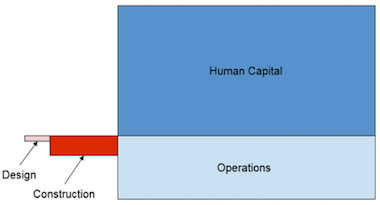
Expanding your horizon: Stakeholders must approach construction from a new perspective
By David Bowcott
Construction InfrastructureThe most important stakeholder within a construction project is the owner. Without their capital there would be no project to bid on. In addition, it’s the owner that makes the ultimate decisions on exactly how the project will be procured and what players will design, build and operate the new asset. It follows that the goal of any project should be to develop a fully operational asset with optimal construction costs and a schedule that delivers performance certainty at the level most desired by the owner.
Each of us as project stakeholders should be working to build an asset that achieves perfection in the eyes of the owner. If we all come together to achieve this goal, everybody wins. So, why is it that we seem to lose sight of the target with many of the projects being delivered in today’s construction economy? Are we really aiming to create an asset that delivers the desired operational performance certainty, or are we too focused on short-term costs at the severe detriment of the long-term objective?
We all know the answer to this question. But it appears there is a collective awakening afoot that will lead all parties to rethink their current procurement strategies and refocus on this long-term objective.
To reprioritize and begin working together toward achieving improved long-term operational performance, we need a collective “North Star.” A concept long-used within the manufacturing industry, Total Cost of Ownership, could provide this guiding light.
Let’s take a deeper look at long-term costs. The pictogram below represents a realistic breakdown of the total cost of ownership for a typical asset’s entire life.
The cost breakdown is not what you may expect. The present value of design amounts to roughly five to 15 per cent of the construction costs. The construction costs represent 10 to 20 per cent of total costs of operations. Finally, the human capital costs (costs of human assets interacting with the physical asset) are double the cost of operational costs. These cost allocations vary from asset type to asset type, however, the exact breakdown isn’t required to understand how significant post-construction costs are to the owner versus those costs required to design and build the asset.
What is amazing about this bird’s eye view of ownership cost is that design represents just 0.5 per cent of the present value cost of all components of the asset over its life (both physical and human assets), while construction represents 4.5 per cent of all component costs of an asset over its life.
Those in the construction sector know that how you design and construct an asset is extremely impactful on the operating costs of the asset over its life. What is perhaps the most startling fact, when viewing an asset’s life from this vantage point, is that most construction done today overlooks these vital allocations almost entirely, and instead, focuses on the cost of design and construction.
If we could actually measure total cost of ownership impacts when making design and construction cost allocations, we could unlock trillions of dollars in total cost of ownership savings to the global economy. How many times have you seen situations where the owner could reap significant operational savings by incurring relatively small increases in design and construction costs? For instance, a change that would increase design and construction costs 10 per cent, which really is a one per cent increase in total costs, could reap a 20 per cent decrease in both operational costs and total costs.
From this perspective, it seems we have lost focus on what our primary goal is when designing, constructing and operating the assets we build. We need to refocus and harness the prodigious power of the technology and data solutions coming to market to reshape the procurement models we use to build a better world.
There has never been a better time to start down this path than now.
This column originally appeared in the February 2019 issue of On-Site. You can read through the full issue here.
David Bowcott is Global Director — Growth, Innovation & Insight, Global Construction and Infrastructure Group at Aon Risk Solutions. Please send any comments to editor@on-sitemag.com.






